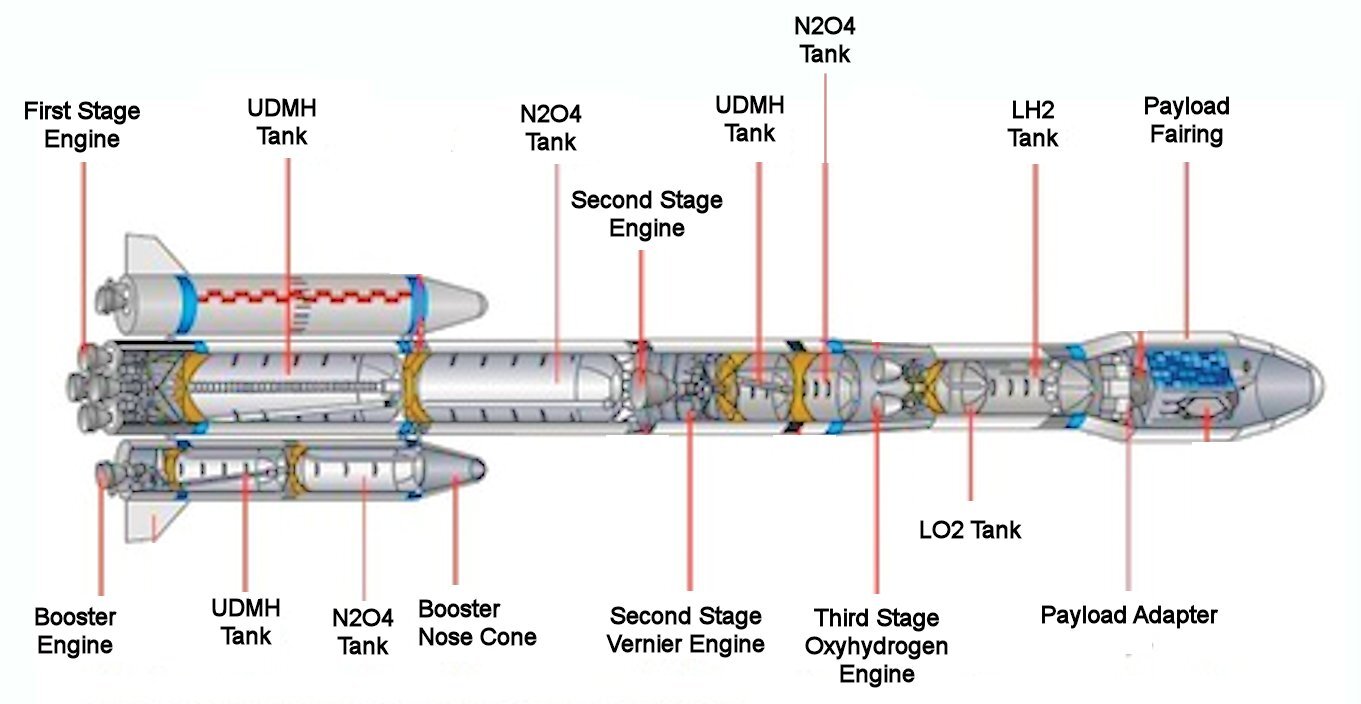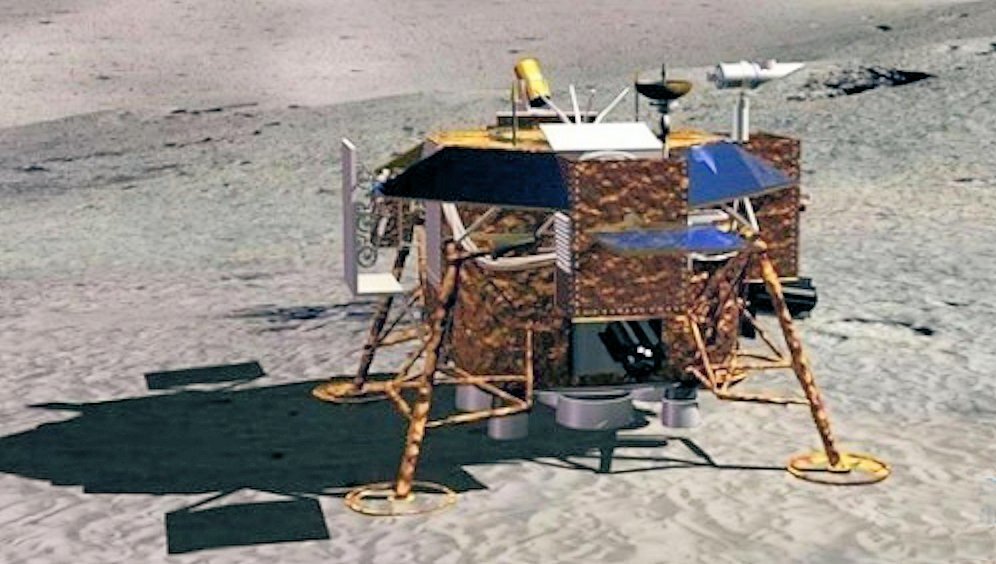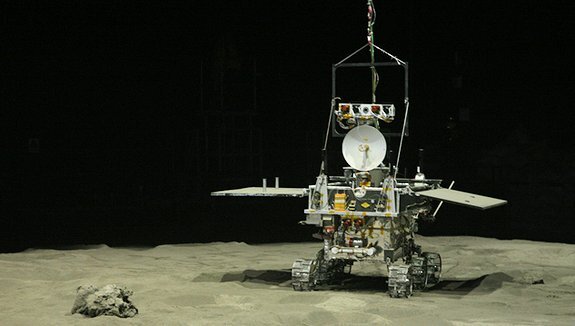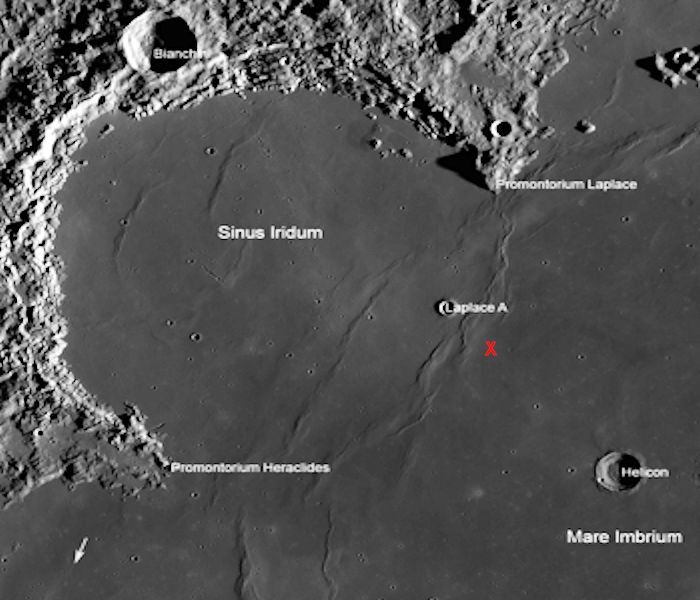China's lunar probe Chang'e-3 was placed into an Earth-Moon transfer orbit on Monday by a Long March 3B launch vehicle from the Xichang Satellite Launch Centre. It has on board a lunar landing module, containing the Yu Tu (Jade Rabbit) lunar rover. If all continues to go well, on December 14 Chang'e-3 will land in Sinus Iridum on the Moon's northern hemisphere. It will be the first spacecraft to make a soft landing on the Moon in 37 years.
The Chang’e-3 mission incorporates two major components, a Lander and a Rover named Yu Tu, or Jade Rabbit, named after the companion of the Moon goddess Chang'e in Chinese mythology. The Lander is 0.83 m (33 in) high, the octagonal body is about 3.8 m (12.5 ft) across, and the four extendable landing legs span 4.76 m (15.6 ft). Fully fueled and carrying the Rover, the Lander has a mass of about 3,780 kg (8,300 lb), about 2,600 kg (5,700 lb) of which is fuel for the lunar descent and landing.
The three-stage Chang Zheng 3B (Long March 3B) launch vehicle used to send the Chang'e-3 probe to the Moon is roughly a functional equivalent of the SpaceX Falcon 9.

The Long March 3B is about 55 m (180 ft) in length, has a diameter of 3.35 m (11 ft), and weighs about 426 metric tons at liftoff. The first two stages and the booster rockets use a N2O4/UDMH (Nitrogen Tetroxide/Unsymmetrical DiMethylHydrazine) oxidizer/fuel combination, while the third stage has a cryogenic hydrogen/oxygen rocket engine. The 3B can lift 12 metric tons into low Earth orbit, 5.1 metric tons into a geostationary orbit, and 3.3 metric tons into an independent orbit around the Sun.
The third stage provides two crucial burns; the first occurs just after separation from the second stage. The purpose of this burn is to inject the third stage and the Chang'e-3 probe into a parking orbit. The rocket follows this parking orbit while the proper orientation is achieved for insertion into the translunar orbit.

A second burn of the third stage engines then pushed the Chang'e-3 into a highly elliptical translunar orbit. Taking the Chang'e-3 to an apogee of 368,000 kilometers, this maneuver was completed about 19 minutes after takeoff. Deployment of Chang'e-3's landing legs and two power-generating solar arrays also was carried out without a hitch. Now the probe will slumber for a few days, until it burns its own engines to enter lunar orbit on December 6.
Then will come the tricky bit, landing safely without any input from controllers on Earth. This requires a combination of inertial guidance, extremely precise range and velocity measurements, image recognition, and a pretty fast computer – not to mention a certain amount of luck.

Chang'e-3 will pass through several distinct stages during the landing procedure. Initially in a circular 100 x 100 km (63 x 63 mi) orbit, it will lower itself into an orbit whose closest approach to the lunar surface is 15 km (9.3 mi). The next step is to break out of that orbit, beginning the landing approach.
As the probe approaches the landing site, it begins to examine the area to look for unexpected hazards. Once over a good tract of land, Chang'e-3 will hover on its rockets, and do a thorough examination of the landing site. It will then avoid any hazards while slowly lowering itself toward the ground. The rockets will cut out when the craft is 4 meters (13 ft) above the soil, allowing it to free-fall until impact with the ground is absorbed by the landing legs. This may sound like harsh treatment, but in a fall of 4 meters under lunar gravity, the impact velocity is only 3.6 m/s, or about 8 mph.

Once landed, the Chang'e-3 lander will carry out some housekeeping tasks and then unload the Yu Tu rover. The lander uses a combination of solar panels and a radioactive thermoelectric generator to supply its power needs, both for operating electricity and for heating during the two week lunar nights. The rover uses only solar panels and batteries to operate during the days, and to store maintenance power for the nights.
Each wheel of the six-wheeled rover is powered by an independent brushless DC motor. When combined with a rocker-bogie suspension system similar to that used by the Mars rovers, the Yu Tu can travel at an amazing one-eighth of a mile per hour, climb 20 degree slopes, and roll over obstacles 20 cm (8 in) in size. The rover is steered by a control system that integrates local hazard analysis with teleoperation by controllers on Earth.

The lander comes equipped with a sophisticated assortment of scientific instrumentation. One is the Lunar Ultraviolet Telescope, or LUT. It is designed to act as a long-term astronomical observatory, the first ever placed on the Moon's surface. The vacuum environment and slow rotation of the lunar environment make an ideal location for near-UV observations that cannot be carried out from beneath the Earth's obscuring atmosphere. The LUT is a 15 cm (6 in) aperture Ritchey-Chretian telescope equipped by a CCD image sensor sensitive to light having wavelengths between 245 and 340 nanometers.
Another optical instrument is the Extreme Ultraviolet Camera intended to monitor the Earth's plasmasphere, which is a magnetically active region within the magnetosphere but above the ionosphere. It works by viewing light with a wavelength of 30.5 nm which is scattered from helium ions in the plasmasphere. The lander is also hosting several other cameras and a lunar soil probe.

Jade Rabbit is arguably fitted out with more sophisticated scientific equipment than any previous rover. Most notable is a powerful ground-penetrating radar capable of penetrating up to 30 meters (100 ft) of lunar soil or about 100 m (330 ft) of lunar crustal material, and analyzing the underlying structure.
The rover is also equipped with an Alpha Particle X-ray Spectrometer (APXS) installed with a sensor head on a robotic arm. The electronics inside remain protected within the rover. APXS, which comes equipped with a 30 millicurie radioactive alpha source, can use particle-induced X-ray emission and X-ray fluorescence to determine the abundance of elements within rock and soil samples, and can also find hidden materials, such as water of crystallization, which is otherwise difficult to detect remotely.
An imaging spectrometer that operates in the visible and near-infrared can quickly obtain data that can guide an initial guess for the identity of a mineral found during a lunar survey. The design that made its way onto the Yu Tu rover is particularly sophisticated, using an acoustic-optic tunable filter to control the imaging wavelengths. Again, there are additional stereo imaging and other special-purpose cameras.

The landing site for Chang'e-3 is in the general area of Sinus Iridum, the remains of a large impact crater which was subsequently flooded with basaltic lava. A precise location has not yet been announced, but speculation centers in the vicinity of crater Laplace A, a small crater that is nearly on the transition region between the lava floods and the more common crustal formations. An exciting prospect – we are likely to learn something new about the Moon in the next few weeks!
Source: NASA Spaceflight.com














